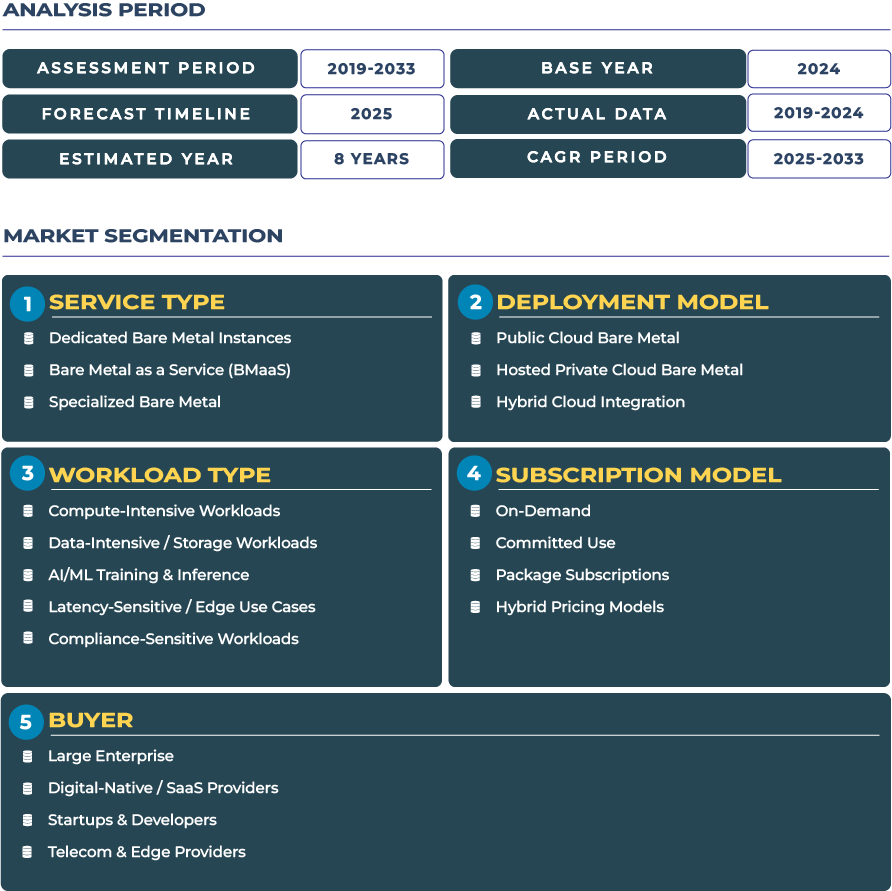North America Cloud Bare Metal Market Outlook: Driving HPC & Low-Latency Innovation with On-Demand Bare Metal
North America has established itself as the leading hub for cloud bare metal infrastructure, primarily driven by its strong enterprise, financial services, and hyperscale technology sectors. The demand for high-performance computing (HPC) and ultra-low latency trading systems has pushed enterprises to move beyond conventional virtualized models toward dedicated, single-tenant bare metal environments. The North America Cloud Bare Metal Market is valued at USD 5,498.5 million in 2025 and is projected to reach USD 14,392.2 million by 2033, expanding at a CAGR of 12.8% from 2025–2033. This growth trajectory reflects the increasing reliance of enterprises on bare metal as a service (BMaaS) and specialized deployments for mission-critical workloads. Financial services institutions in New York, Chicago, and Toronto, as well as tech hubs across California and Texas, are among the most active adopters of on-demand bare metal, fueling robust growth across the region.
Unpacking the Key Growth Drivers: Rising HPC Demands and Low-Latency Enterprise Requirements
The growth of the North America cloud bare metal industry is closely tied to rising HPC adoption and real-time data processing requirements. Financial trading firms demand ultra-low latency environments to gain competitive advantage, leading to strong uptake of dedicated bare metal instances that minimize performance overhead. In parallel, sectors such as genomics, weather modeling, and energy simulations rely heavily on HPC-driven workloads that cannot tolerate virtualization bottlenecks. Moreover, the rise of data-intensive AI/ML workloads in research labs and corporate innovation centers across the United States and Canada has fueled significant demand for specialized bare metal solutions. Another driver is the region’s robust digital economy and federal initiatives promoting innovation in cloud infrastructure, which accelerates investment into next-generation HPC-ready cloud bare metal ecosystems. Collectively, these factors ensure sustained momentum in the North America cloud bare metal landscape.
Barriers Hindering Growth: Capital Intensity and Security Complexities
Despite its strong growth trajectory, the cloud bare metal sector in North America faces structural challenges. High capital and operational expenditures remain one of the most significant barriers, as enterprises must balance between long-term dedicated server costs and the flexibility of virtualized cloud models. Security concerns also play a central role. Bare metal deployments, while isolated and high performing, are not immune to firmware-level attacks and persistence threats, which can compromise infrastructure integrity. Enterprises in sectors such as banking and government agencies are particularly cautious due to the sensitivity of workloads. Additionally, regulatory requirements in regions like California and New York create compliance-related overheads. The shortage of specialized technical talent capable of managing complex bare metal infrastructure further restrains seamless adoption. These hindrances underscore the need for providers to innovate on pricing models, strengthen endpoint protections, and simplify the operational complexity of bare metal as a service.
Emerging Trends & Untapped Opportunities in the North America Cloud Bare Metal Ecosystem
Key trends shaping the North America cloud bare metal landscape include increasing adoption of single-tenant cloud infrastructure for mission-critical applications and the rising use of liquid cooling technologies to support dense HPC clusters. These advancements enable enterprises to unlock performance while addressing sustainability concerns. The trend of hybrid IT models is also gaining momentum, with enterprises blending on-demand bare metal with traditional virtualization to optimize workload management. On the opportunity front, providers are exploring underserved enterprise markets in regions such as rural Canada and secondary U.S. states, where enterprises lack access to advanced HPC-ready infrastructure. Additionally, the push toward carbon-neutral data centers presents a significant opportunity. Several providers are investing in green bare metal infrastructure powered by renewable energy, aligning with sustainability mandates issued by U.S. Environmental Protection Agency. These opportunities reinforce the evolution of a more resilient, sustainable, and regionally distributed cloud bare metal ecosystem.
Regional Analysis by Country
-
United States
The U.S. dominates the North America cloud bare metal market due to its strong base of financial services firms, hyperscale cloud providers, and HPC-driven research initiatives. Enterprises in Silicon Valley, New York, and Washington are increasingly adopting bare metal as a service to support high-intensity workloads. Federal cybersecurity programs also encourage secure infrastructure expansion.
-
Canada
Canada is experiencing steady growth in specialized bare metal deployments, particularly within Toronto’s financial hub and Montreal’s AI research ecosystem. Government-backed initiatives to strengthen digital infrastructure and national data sovereignty are encouraging enterprises to move workloads onto dedicated bare metal platforms.
-
Mexico
Mexico is emerging as a strategic location within the North America bare metal sector, supported by rising digital transformation across manufacturing and telecom. Enterprises are showing preference for on-demand bare metal instances that provide agility without upfront capital investment, making the country a promising growth frontier.
Competitive Landscape: North American Providers Driving Bare Metal Expansion and Innovation
The North America cloud bare metal market is characterized by strong competition among both global and regional providers. Major players such as IBM, Equinix Metal, and OVHcloud have expanded their bare metal offerings to cater to enterprise-grade HPC and financial workloads. In 2023–2024, a leading provider launched expanded on-demand bare metal capacity across multiple North American regions to match peak enterprise demand. Companies are focusing on differentiated strategies including specialized bare metal for AI/ML workloads, integration with hybrid cloud frameworks, and sustainability-driven infrastructure powered by renewable sources. These competitive moves highlight how providers are positioning themselves to capture high-value contracts in finance, research, and manufacturing, while simultaneously aligning with regional sustainability commitments.








